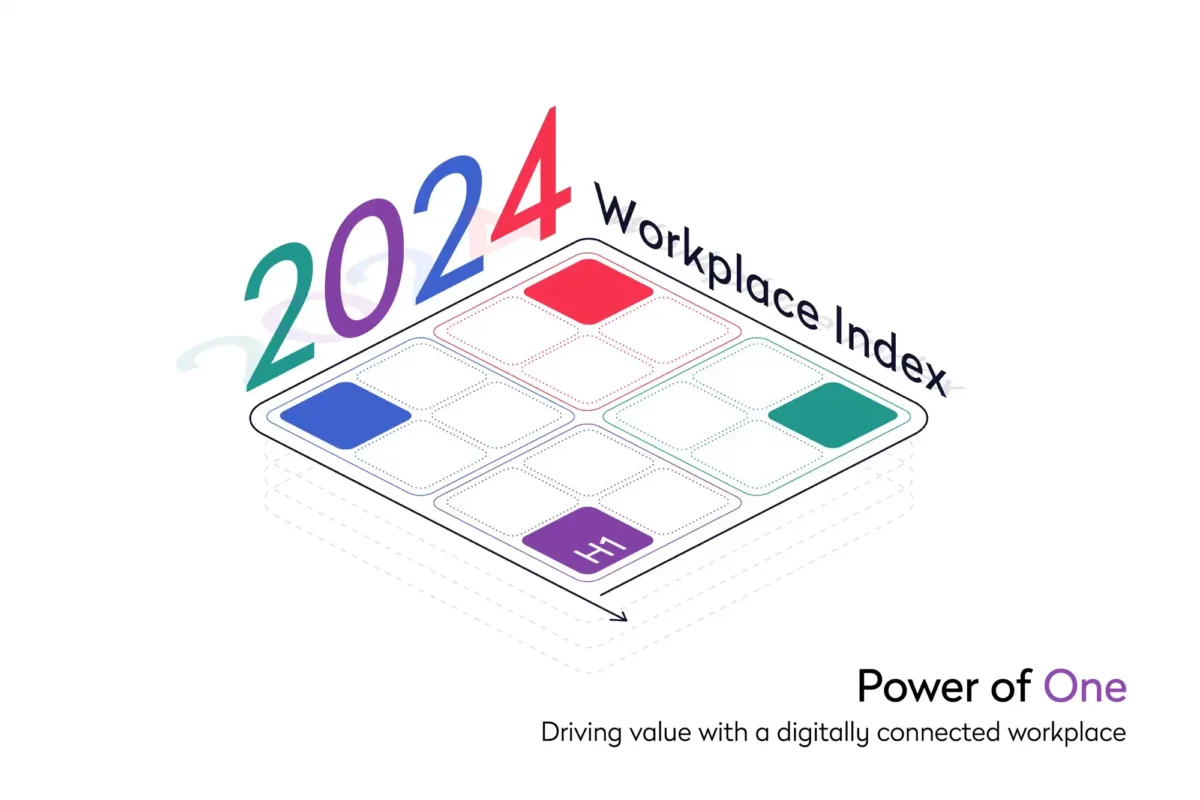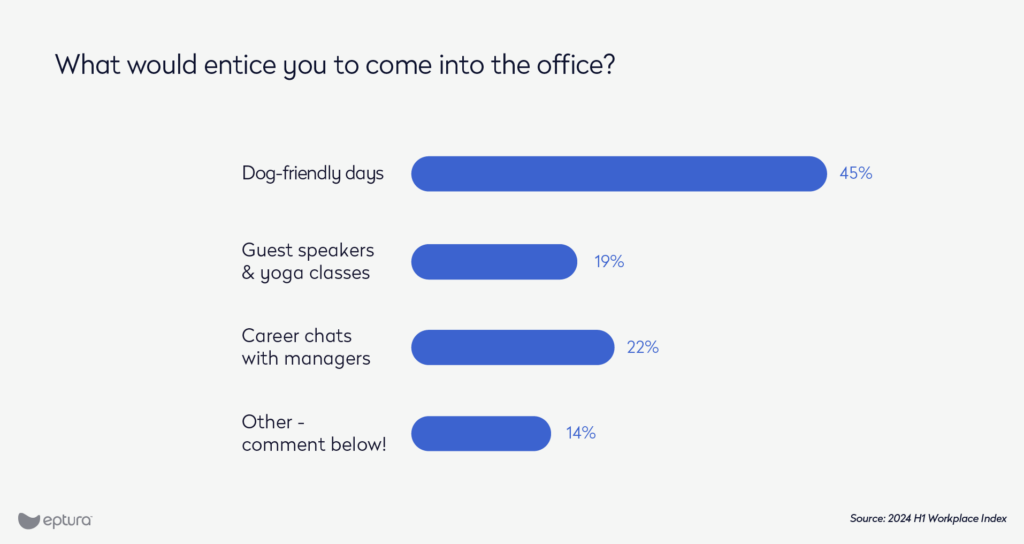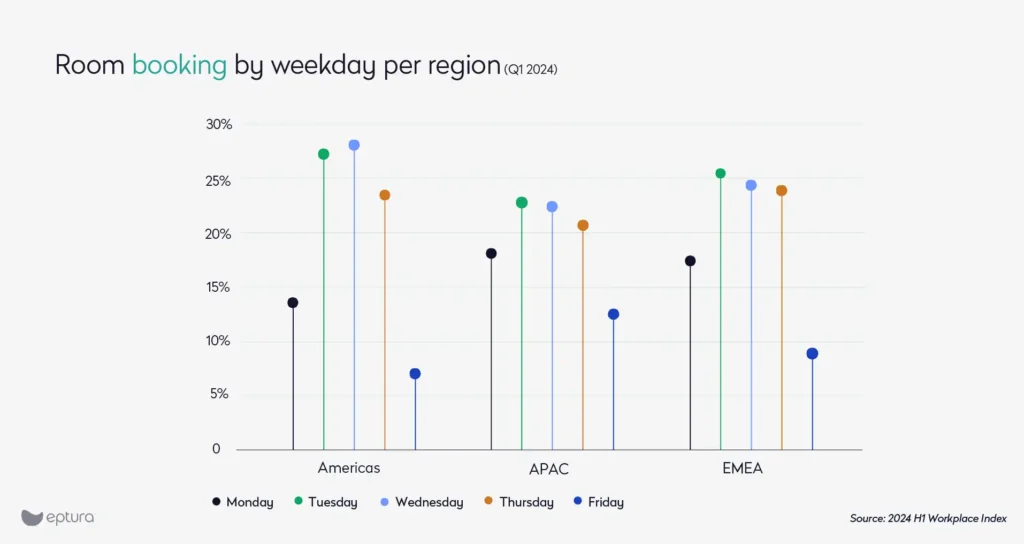
According to research from Eptura, office occupancy rates are growing, but they are not expanding. Around the world and across industries, there are more people coming into the office, but they’re not there on more days. Instead, organizations are seeing “midweek mountains,” with numbers peaking Tuesdays through Thursdays.
Although there are ways facility and workplace leaders can leverage this trend, some will want to flatten the curve to optimize utilization rates and level demand on services, allowing them to control costs while delivering the best possible employee experience.
Eptura’s H1 2024 Workplace Index features proprietary research from enterprises in North America, Europe, and Asia Pacific, and leverages anonymous user data from over 5,000 companies, covering 19,000 buildings, 95.5 million desk bookings, and 25 million room bookings. And our recent week-long online poll looked specifically at ways organizations can encourage employees to work from the office outside of midweek peaks.
What is the midweek mountain?
Starting with our first Workplace Index in Q1 2023, Eptura has been reporting on the midweek mountain, where employees opt to work away from the office on Mondays and Fridays, creating occupancy clusters on the remaining three days.
Charting room booking data from Q3 2022 to Q1 2023 first revealed two important trends. While the number of people coming into the office was steadily increasing, the days they were working from the office remained roughly the same. Both trends are consistent across our Index reports.
One of the many interesting aspects of the midweek mountain is its near universality. Our data from the Americas, APAC, and EMEA reveal it to be a global trend, with no observable differences across industries, making it an important part of the global workplace. Facility and workplace managers need to understand it, leverage it to increase operational efficiencies, and if circumstances require, find ways to flatten it.
What’s causing the midweek mountain?
Our data not only revealed its existence but also helps explain why it’s happening.
Across reports, employees have been telling us they come to the office to connect and collaborate with coworkers. In the Q3 2023 Workplace Index, for example, the top two motivators to visit the office where “Socializing with friends/colleagues” and “Collaborating with colleagues.”
And when asked what would make employees want to use their workplace more, the top three most selected responses were:
- More social areas such as cafes and outdoor spaces at 45%
- Better technology like collaboration and scheduling software at 38%
- More recreational areas like pool tables and table football at 34%
All of these are related to spending time connecting and collaborating, further proof that for many, the biggest reason to come to the office is because other employees are there. It’s worth noting that our research also reveals additional motivations, including wanting a clear boundary between home and work, having access to office equipment, and needing quiet space to work.
But for many, the modern workplace is mainly about other people.
What are the possible advantages and challenges of midweek workplace occupancy peaks?
Once a trend appears, you can use it to improve planning and preparation. Hotels are never caught unprepared at the start of the annual high season, and campus facility managers have everything lined up to go before September.
For facility and workplace leaders, there are ways to take advantage of a midweek mountain. Traditionally, it has been harder to schedule preventive maintenance and on-demand repairs during regular working hours.
When the offices are full of employees, there’s little room for maintenance technicians to move desks to access HVAC, for example, and few opportunities to shut down elevators for inspections without inconveniencing employees. But if a facility manager knows Mondays tend to have low occupancy numbers, they can schedule larger projects for when there’s fewer people onsite.
The same is true for much of the janitorial work. Teams can schedule lighter, more frequent cleaning for busier days, while keeping deeper, louder cleaning to Fridays. Office managers might have to restock the employee kitchen once a week, and with the midweek mountain, it makes the most sense to do it late Monday, in anticipation of the Tuesday rush.
That said, there are many reasons companies want to have offices just as full Mondays and Fridays, including boosting utilization numbers and reducing the likelihood of demand spikes for everything from parking spaces to employee service requests.
How can organizations flatten the midweek mountain?
Eptura recently ran an online poll to collect insights into what would bring more people into the office Mondays and Fridays.
The poll asked, “The days of requiring all employees to work in office locations 100% of the time are long gone, but in-person collaboration still plays an important part in company culture, productivity, and satisfaction. We’ve heard varying approaches to magnetizing the office, from commute stipends and professional advancement programs to health and childcare. What would entice you into the workplace for collaboration days?”
There was a real diversity of opinion, but also a clear winner.

Out of a total of 120 votes, 14% picked “Other,” with opinions including a quiet place to work and access to better computers and a faster network. Those answers were not surprising, because they closely match data from our Workplace Index reports.
In third place was “Career chats with managers,” with 22% of the vote. Again, this matches earlier insights from the Index reports. The online poll did not collect data on respondents’ ages, but it would be interesting to learn if this answer is more popular with younger employees. Often, mentoring opportunities work best face-to-face, so it could be employees earlier in their careers who would want to come in to meet with managers. Professional development does make sense at every stage, though, so it’s just as likely this option is popular with people further along their career paths.
“Guest speakers and yoga classes” took second place with 19%, and it’s not hard to understand why. Both are activities employees can’t or are unlikely to do alone from home or at a desk in a shared workspace. Many larger, enterprise-level organizations bring in well-known speakers for lunchtime presentations, and employees are more likely to make the commute on days they have opportunities to attend lectures they otherwise couldn’t.
It’s also not surprising that both activities have a clear social aspect to them, which matches the overall trend of people wanting to come to the office specifically for chances to connect and collaborate with colleagues.
Dominating first place was “Dog-friendly days” with 45% of the votes. When people are at home, they miss connecting and collaborating with coworkers. But at the office, they miss the comfort they get from their canines. So, it’s likely they feel that bringing their dogs to the office gives them the best of both.
Organizations looking to flatten the midweek mountain could start offering different opportunities on days they want to see higher occupancy rates. Managers could set aside blocks of time Mondays and Fridays for informal meetings with their reports. Guest speakers could be moved to Friday afternoons, while yoga classes could be every Monday morning.
And instead of a blanket dog-friendly office policy, companies could allow dogs in the office on specific days only. The general concept is not new. Day-specific perks like Casual Fridays have been a staple of office culture for decades. Companies can now start to look at a wider variety of variations that appeal to their employees.
Modern worktech helps enterprise-level organizations track, manage, and flatten the midweek mountain
Being able to manage this trend requires investments in modern worktech that empowers organizations to capture occupancy data, calculate utilization rates, and leverage it all into actionable insights. You can’t take advantage of the midweek mountain without first knowing if it’s happening in your offices. Organizations need to know if it’s arrived and then how it’s fluctuating, growing stronger or fading.
A modern integrated worktech platform also ensures your employees can make the most of the trend, streamlining the process of reserving desks, rooms, and spaces through predictive artificial intelligence and intelligent booking software. Employees can arrive ready to work productively every day of the workweek.





